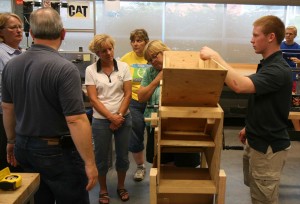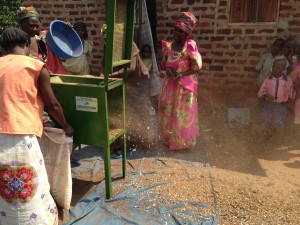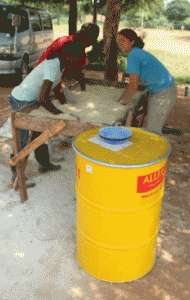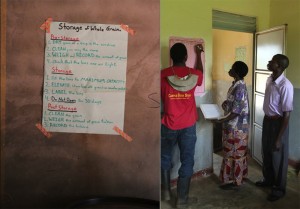Summer provides opportunities for Iowa State students to apply their engineering skills to African agricultural practices and education.
Two Iowa State student engineers visited the Kamuli District in Uganda this past summer with different groups and for different projects. However, they shared the same goal: enhance the quality of life in rural African communities.
Hand-operated fanning mill saves time cleaning seed
In mid-July, Anastacia “Stacy” MacAllister, who is a grad student in mechanical engineering, traveled to the Kamuli District to assess a fanning mill project that has been ongoing since 2011.

This project originally began when sophomore engineers, in collaboration with ISU-based Value Added Agriculture Program (VAAP), built a wooden, hand-powered fanning mill to help African farmers clean their seeds of chafe and dirt.
“Previously, farmers could only clean 100kg, or about four bushels of soybeans, in two days, spending around 16 hours on the process, which comes out to about ¼ bushel per hour. With the fanning mill, farmers could process 6.6 bushels each hour,” an earlier College of Engineering story said.
VAAP sent the sophomore engineering-designed machine over to Uganda where it was introduced to farmers in Kamuli. It worked really well, MacAllister said, but there was just one problem – it was made of wood and vulnerable to rot and insects.
In response, a team of mechanical engineering seniors, including MacAllister, picked up the project in the spring of 2013 for ME 415 and started to redesign the seed cleaner using steel parts.
By the end of the semester, she says her team had essentially designed the core components of the new machine. “It wasn’t quite ready for primetime,” she said, but enough progress had been made to send a steel prototype to Tonnet Agro Engineering, a manufacturing company in Kampala, Uganda, and begin locally sourcing the machine.
In August 2013, MacAllister and Margaret Smith, who is a co-director of VAAP, flew over to help Tonnet finish the designs. Tonnet manufactured eight fanning mills that ISU purchased and issued to 16 farmer groups in the Kamuli District for testing.
Eight more machines were later built in January 2014 and distributed to VEDCO (Volunteer Efforts for Development Concerns), St. Joseph Vocational Training Center and six women’s farm groups.
MacAllister, accompanied by former ISU employee Jennifer Steffen, embarked on a second trip in July to check on the machine and interview the farmer groups who have been testing it. Overall, the trip was successful.

“The design is holding up well and meets the majority of their needs while coming in at a low cost,” she said.
It’s also saving the famers time, which has especially benefited women farmers. They use this extra time to expand their gardens to grow more food or focus on other activities, such as hand weaving baskets to sell in the market, MacAllister said.
However, low income and limited access to banking resources make the machine a large investment. It costs roughly 831,000 Ugandan shillings ($300) to manufacture, and many of the interviewed farmers were willing to pay up to 275,000 shillings ($90).
“In this situation, the right resources and intervention, like microfinance, could help to put the machine within their reach, cost wise,” she said.
The College of Engineering and College of Agriculture and Life Sciences are currently building a new website that will provide updates on the fanning mill project.
Hermetic systems protect grains and kill pests

As MacAllister and Steffen were interviewing farmers, Christian Miller, who is a senior in biological systems engineering, was working nearby on a service learning project to help improve the grain storage practices at three schools in the Kamuli District.
The service learning project is an ongoing effort of ISU’s Center for Sustainable Rural Livelihoods.
These schools collect grains, such as maize, soya beans and rice, from students as part of their tuition to be used for school meals. Originally, they used woven polypropylene bags to store their grains.
Hermetic storage systems, on the other hand, use airtight seals to eliminate oxygen in a storage unit, Miller explained. This technique helps to improve storage potential by killing pests through asphyxiation.
Service learners introduced the concept in 2013 using used 45-55 gallon plastic and steel food containers that originally held sugar syrup or fruit preservatives. The barrels kept the rodents out and provided an airtight storage environment.
However, there were many accidents following the initial project. Miller said people would open the barrels prematurely, flooding them with fresh air that revitalized the bugs and their voracious appetite.
“It has to be sealed long enough for the bugs to asphyxiate,” Miller explained. “They didn’t truly understand the system.”
So Miller and his group went to each school to teach faculty, staff and students about how to best use the recycled food containers, including posters with step-by-step directions on pre-storage practices.

In addition to teaching about grain storage, Miller also taught math and science to primary school pupils there.
“My favorite experience was teaching the pupils of Kamuli. Those kids have very hard lives and after working in the garden and fetching water in the morning, they walk all the way to school to learn,” Miller said. “That is a very memorable testament to the meaning of education. And on the last day, some of the kids told me ‘Good luck on your future.’ They told me that, even though they are in the position that they were in, with lower health standards and less access to ‘common’ utilities.”
While it’s currently difficult for them to say how much impact hermetic storage systems and hand-powered seed cleaners will have, MacAllister and Miller hope their projects have raised awareness and proved that these technologies can make a difference in enhancing the lives of people in Uganda.